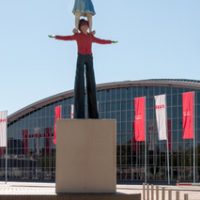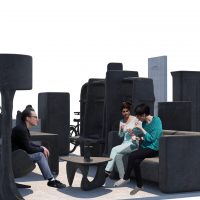Ode to Mingus; Spire; Menhir Tower, Hans van de Bovenkamp
Gustav Mahlerplein
Gustav Mahlerplein is at the heart of the Zuidas. The square has developed in pace with its environment and has gone through many transformations. We’re taking a look at the various artworks that have adorned the square in the past years.
When you have your back turned to Hildo, you’re looking out over Gustav Mahlerplein. A square in general serves as a good metaphor for society on a small scale. It is public domain at its best: a platform for social contact and the different authorities controlling its organisation are all visible. The analysis of a square and how it affects its surroundings gives us insight into how public space operates. Gustav Mahlerplein is at the heart of the Zuidas. Its central location is one of the reasons that in the past it was repeatedly used as a podium for the arts and as such it has a rich history of art in public space. The square developed in pace with its environment and has gone through many transformations. A brief overview of the art this place has given rise to:
Fortuna
In March 2015 a yacht stranded on the square, as designed by Leonard van Munster. He designed the work in 2012 when he was artist in residence at the Zuidas (which was an initiative of the Virtual Museum Zuidas). But because sponsors were hard to find –companies in the area weren’t willing to invest- it took three years to realise the work. The ship was eventually christened Fortuna, after the goddess of chance and good and bad luck. This work is a prime example of the social criticism which a public square traditionally facilitates. A stranded ship in the financial heart of the Netherlands- for van Munster this depicted our society in times of crisis. For a ship evokes multiple associations: the yacht can be a symbol for the wealth (and the demise) of the elite, but can also be seen as a means to escape this capitalist world, a beacon of hope.
In May 2015 the shipwreck was removed and the area was cleared so that renovations to the square could kick off. Before the construction of the Zuidasdok (the A10 underpass) began, an underground bicycle parking system was built. The square was refurbished and the white benches made way for flower beds.
Palace Ruin
In July 2016, renovations were completed and Gustav Mahlerplein was back in operation. Within a month a new artwork was revealed, this time by James Beckett. For his installation Palace RuinBeckett partly rebuilt the Paleis voor Volksvlijt, an iconic building in Amsterdam dating from 1860, which was destroyed by fire in 1929. Palace Ruin represents a remnant of the building as it looked the day after it went up in flames.
In his work, Beckett often aims to connect the past and the present. The design for the Paleis voor Volksvlijt inspired many modernist buildings, with its characteristic glass, high-rise and geometric elements which are visible at the Zuidas too nowadays. For two months the work served as a stage for experimental music performances and presentations. Gustav Mahlerplein is situated amidst the ‘palaces’ where the masters of the present day, neoliberal world order plan their strategies. As such, Palace Ruinis literally a platform for art and culture in the business world.
Ode to Mungus, Menhir Tower andSpire
These three sculptures on Gustav Mahlerplein were not originally included in the plan for the renewed square. They were installed during ARTZUID, the sculpture biennial in Amsterdam-Zuid. They were made by the artist Hans van de Bovenkamp. Dating from 2006, 2008 and 2010 respectively, the sculptures weren’t conceived specifically for the square, but they were placed here because their abstract design and baroque elegance form a nice contrast to the Zuidas’ austere architecture. Unlike the preceding artworks these were not made in relation to their environment, but a relation does come about eventually, as it often does in public space- whether that was meant to happen or not.
These three artists, expressing different views, indirectly lay bare the different power structures controlling public space. The control is not only in the hands of the government, residents too actively create public space by using it the way they choose to. The artworks at Gustav Mahlerplein are food for discussion, in the public realm as well as in their direct physical environment. As such, they take part in the manifestation of social behaviour ón the square.
More information
Meer sculpturen op de officiële website Hans van de Bovenkamp: http://www.vandebovenkamp.com/gallery4.htm









